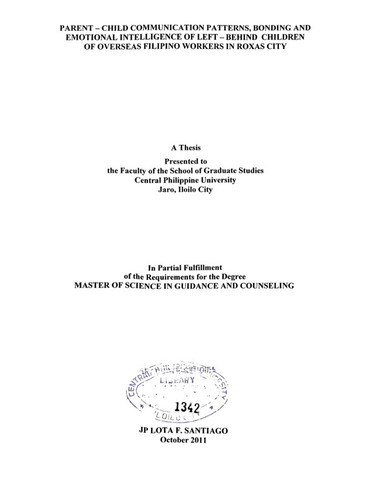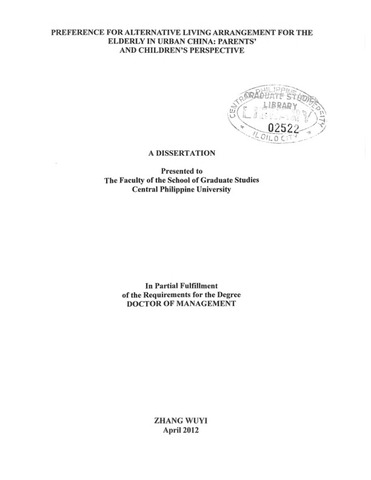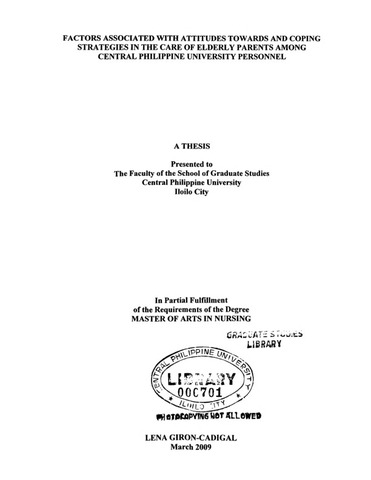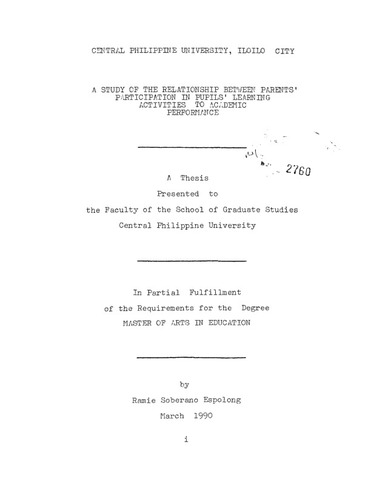Parent-child communication patterns, bonding and emotional intelligence of left-behind children of overseas Filipino workers in Roxas City

Page views
21,768Date
2011Auteur
Thesis Adviser
Defense Panel Chair
Share
Metadata
Afficher la notice complète
Résumé
This study was conducted to determine the relationship between the parent - child communication patterns, bonding and emotional intelligence of the left-behind children of Overseas Filipino Workers (OFW) in Roxas City. Specifically, it sought to describe the characteristics of left-behind children of OFWs as to their sex, sex of their OFW parent, age during first separation, length of separation, and surrogate parent; describe the communication patterns and parental bonding of the left-behind children with their OFW parent during separation; describe the total emotional quotient of the left-behind children and the five meta-factors of their emotional intelligence namely interpersonal, intrapersonal, stress management, adaptability, and general mood; determine the significant relationship between the characteristics of left-behind children and their communication patterns and parental bonding with their OFW parent during separation; determine the significant relationship between the characteristics of left-behind children of OFWs and their total emotional quotient and the five meta-factors of their emotional intelligence; and, determine the significant relationship between their communication patterns and parental bonding and their total emotional quotient and meta-factors of their emotional intelligence.
This is a quantitative study that used a one -shot survey design. From a total of 226 children of OFWs in the four private schools in Roxas City, a sample of 142 was obtained using stratified random sampling. Standardized tests were used to measure the parental bonding and emotional intelligence of the respondents and a researcher-made questionnaire was used to gather data on their characteristics and communication patterns. The Parental Bonding Instrument was used to measure the parental bonding of respondents with their OFW parent and the Bar On Emotional Quotient Inventory: Youth Version (Bar-On EQ-i: YV) was used to measure the respondents’ emotional intelligence. The descriptive data on the respondents’ characteristics, communication patterns, parental bonding, and emotional intelligence were analyzed using the frequency distribution, mean, and standard deviation. Chi square, Cramer’s V, Gamma, and Pearson’s Product Moment were used in determining the relationship between the variables. The data processing was done with the aid of Statistical Package for Social Sciences (SPSS) version 17.0.
Findings in determining the relationship between the parent-child communication patterns, bonding, and emotional intelligence, the study has the following findings: More than half of the respondents are females, are children of OFW fathers, and are living with their non-migrant parents. As to their age during first separation and length of separation, most children were left by their OFW mothers when they were six years old and older and are separated from them for not more than seven years.
Moreover, more than a quarter of the respondents who have OFW fathers were separated from them when they were six years old and older and more than a quarter of the respondents were separated from their OFW fathers before they were born. It was further found out that half of these children were separated from their fathers for 11 years or more. With regards to the respondents’ communication patterns, all said that they communicate with their OFW parents during their separation. Most of them use four to six media in communicating with their OFW mothers. These means of communication are phone call, text, chat, webcam, social networking, and email. On the other hand, a maximum of three media are used by respondents in connecting with their OFW fathers, which are phone call, text, and webcam. Moreover, more than three -fourths of the respondents communicate with their OFW parents for not more than three times a week for not more than one hour. They talk about almost everything or discuss four to six issues during their communication with their OFW parents. The left-behind children often talk about studies, health, family relationships, finances, leisure activities, and expression of love and care with their OFW mothers while they talk about studies, health, finances, family relationships, sharing of feelings, and leisure activities with their OFW fathers. Spiritual concerns and boy-girl relationship were found out to be the least -talked - about topics during communication between the children and their OFW parents.
As to the respondents’ bonding with their OFW parents, a bigger percentage of them have affectionless control bond with their OFW mother while among children with OFW fathers, most of them have affectionate constraint bond with their OFW fathers. This means that most of the OFW mothers are perceived to be less caring and overprotective while most OFW fathers are viewed to be more caring and also overprotective.
The result further reveals that both OFW parents were perceived to be overprotective or highly controlling. Moreover, a minority of the respondents said that they have a neglectful bonding with their OFW parents. This means that only a few children perceive their OFW parent to be less caring and less controlling. With regards to the respondents’ emotional intelligence and its meta -factors, more than half of them have average total EQ.
Moreover, almost three -fourths of them have average intrapersonal and stress management skills while majority have average, low, very low, or markedly low interpersonal skills, adaptability, and general mood. As to the respondents’ characteristics and communication patterns, no significant relationship was found between their sex, sex of OFW parent, surrogate parent, age during first separation, and length of separation from OFW parent and their number of communication means used, frequency and length of communication, and number of issues or concerns discussed during communication. It revealed that their characteristics have no bearing at all on their patterns of communication with their OFW parents.
As to the respondents’ characteristics and parental bonding, it was found out that the absence off at her only or both parents is significantly associated with the children’s bonding with their OFW fathers. This tells that the children who were separated from their father only have affectionate constraint bond while those children separated from both their parents tend to have affectionless control bonding with their OFW fathers. Moreover, the respondents’ characteristics are found to have no association with their bonding with their OFW mothers.
This means that the respondents’ sex, sex of OFW parent, surrogate parent, age during first separation, and length of separation from OFW parent has no bearing on their bonding with OFW parents. As to the respondents’ characteristics and emotional intelligence, it was found out that the sex of their OFW parent and their age during first separation from their OFW fathers are associated with their intrapersonal skills. This means that the children with OFW mothers have higher intrapersonal skills than children with OFW fathers. The result also tells that the younger the child during separation from his or her OFW father the lower also are his or her intrapersonal skills. Also, their sex was found to have a significant association with their interpersonal skills. This tends to tell that females seem to have higher level of interpersonal skills than males. Moreover, the respondents’ characteristics were found to have no significant association with their stress management, adaptability, general mood, and total emotional quotient. With regards to the respondents’ communication patterns and emotional intelligence, it was found out that the respondents’ number of issues and concerns discussed during communication is significantly associated with their total EQ. This tells that the more issues or concerns discussed during communication, the higher also is their total EQ. Furthermore, it was also found out that their length of communication and number of issues discussed during communication was found to have a significant association with their general mood.
This means that the longer the communication with their OFW parents, the higher also is their general mood. Likewise, the more issues or concerns discussed during communication, the higher also is their level of happiness and optimism. Moreover, the respondents’ communication patterns were found to have no significant association with their intrapersonal skills, interpersonal skills, stress management, and adaptability. With regards to the respondents’ parental bonding and emotional intelligence, it was found out that their bonding with their OFW mothers is significantly associated with their level of stress management. It tells that the children who have optimal bonding with their OFW mothers tend to have higher stress management skills than those with other categories of parental bonding.
Moreover, no significant relationship between the respondents’ parental bonding and intrapersonal skills, interpersonal skills, adaptability, and general mood was found. Finally, the respondents’ parental bonding was found to have no significant association with their total EQ. This means that the respondents’ optimal bonding, affectionate constraint bond, affectionless control bond, or neglectful bonding with their OFW parents have no bearing with their total EQ.
Conclusion In light of the findings derived from this study, the following conclusions were deduced: Most of the left-behind children who are enrolled in private high schools in Roxas City are females, are often taken care of by their non-migrant parents and were separated from their OFW parents for almost their entire elementary life. For children who have OFW mothers or fathers, their mothers tend to leave them when they were about to start their schooling in elementary while fathers tend to leave them before they were born. However, when the child is already born, fathers suspend their migration until their child reaches the age of six or starts to go to elementary school.
The OFW parents and their children maintain a regular communication with each other during their separation mostly through the use of phone call and text messaging. They tend to communicate at a lesser frequency and with a lesser length. They communicate only once a week for less than one hour and talk about almost everything. Most of the left-behind children have average total emotional quotient. As to the meta-factors of their emotional intelligence, most of them have average level of intrapersonal skills and stress management skills but tend to have lower interpersonal skills, adaptability, and general mood.
The children’s sex, the sex of their OFW parents, their surrogate parents, their age during their first separation from their OFW parents and their length of separation from their OFW parents have nothing to do with their communication patterns. As to the children’s characteristics and parental bonding, it was found out that the children who were separated from their OFW fathers only tend to receive more care and overprotection from their migrant fathers but those children separated from both parents perceive their OFW fathers to be less caring and overprotective. Moreover, the respondents’ characteristics have no bearing on their bonding with their OFW mothers. As to the children’s characteristics and emotional intelligence, those who were separated from their OFW fathers at an older age have higher self-esteem and a positive self-worth. Also, more female left-behind children have higher level of interpersonal skills than males. However, the children’s characteristics have no bearing on their total emotional quotient. As to the children’s communication patterns and total EQ, it was found out that the more topics discussed during the communication, the higher is the children’s emotional intelligence. This may be due to more insights that the child can gain from a rich conversation from their parents.
Moreover, as to their communication patterns and the meta-factors of their emotional intelligence, it was found out that the greater the length of communication and the more issues or concerns discussed by the children and their OFW parents during communication, the happier and more optimistic the children will be. As to the respondents’ parental bonding and emotional intelligence, it was found out that the more care and lesser control given by the OFW mothers to children tend to foster the children’s higher capacity to face and handle stressful situations. Finally, the bonding of the left-behind children with their OFW parents was found to have no bearing with their total EQ.
Description
Abstract only
Suggested Citation
Santiago, J. L. F. (2011). Parent-child communication patterns, bonding and emotional intelligence of left-behind children of overseas Filipino workers in Roxas City. (Unpublished Master's thesis). Central Philippine University, Jaro, Iloilo City.
Type
ThesisSujet
Parent and child  ; Communication
; Communication  ; Children of working parents
; Children of working parents  ; Children of working parents--Attitudes
; Children of working parents--Attitudes  ; Communication in families
; Communication in families  ; Interpersonal communication in children
; Interpersonal communication in children  ; Employment in foreign countries
; Employment in foreign countries  ; Emotional intelligence
; Emotional intelligence  ; Parent and child--Bonding; Philippines--Roxas
; Parent and child--Bonding; Philippines--Roxas  ; Foreign workers, Filipino
; Foreign workers, Filipino 
Keywords
Department
School of Graduate StudiesDegree
Master of Science in Guidance and CounselingShelf Location
GSL Theses 371.4072 Sa59
Physical Description
xii, 194 leaves
Collections
Related items
Showing items related by title, author, creator and subject.
-
Preference for alternative living arrangement for the elderly in urban China: Parents’ and children’s perspective
Wuyi, Zhang (2012)The primary of objective of this study was to determine the parents’ and children’s preference for alternative living arrangement for the elderly in urban China. The study further aimed to determine the relationship between ... -
Factors associated with attitudes towards and coping strategies in the care of elderly parents among Central Philippine University personnel
Cadigal, Lena G. (2009)This study measured the attitudes and coping strategies of CPU personnel during summer 2008 with elderly parents and identified their demographic characteristics (sex, civil status, family income, and number of parents; ... -
A study of the relationship between parents' participation in pupil's learning activities to academic performance
Espolong, Ramie Soberano (1990)The study attempted to find out the relationship of parents' participation in pupils learning activities on academic performance; considering other characteristics of pupils such as their intelligence, household income, ...





